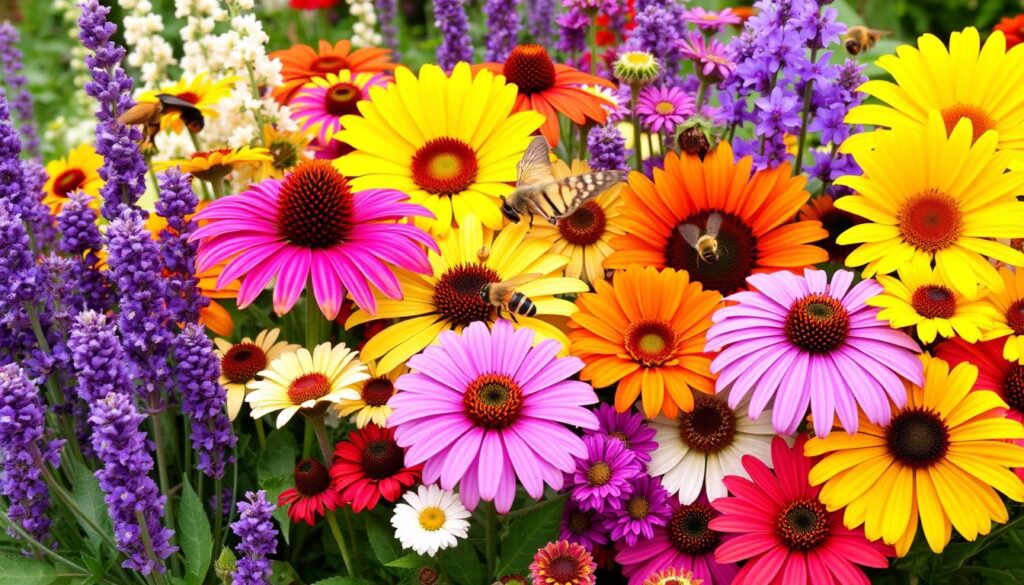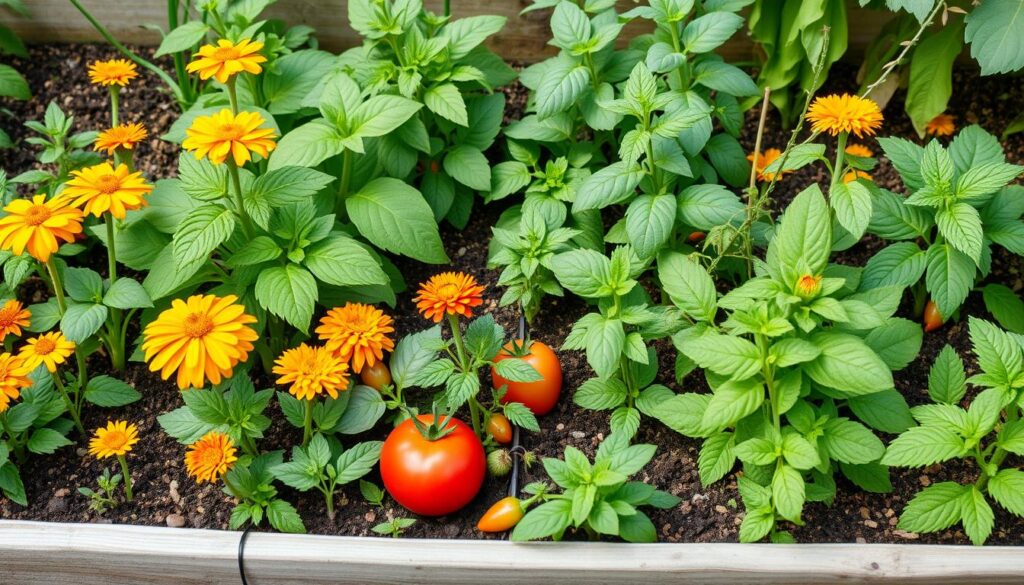Companion Planting for Small Vegetable Gardens: Boost Growth and Deter Pests
Ever thought about making your small garden a place of growth and balance? Companion planting is the key to unlocking your garden’s full potential. It’s an old trick that pairs plants together to fight pests and boost health.
But what makes this method work? How can you use it to make your garden thrive with little effort? Let’s dive into the world of companion planting for small gardens and find out.
Key Takeaways
- Companion planting is the strategic pairing of plants to create mutually beneficial relationships in your garden.
- This technique can deter pests, attract beneficial insects, improve soil fertility, and increase overall plant yields.
- Companion planting is especially valuable for small gardens, where space is limited, and every square inch counts.
- By understanding the unique properties and interactions of different plants, you can cultivate a thriving, low-maintenance garden.
- Companion planting is a key strategy in organic and sustainable gardening practices, allowing you to grow a bountiful harvest while minimizing the use of harmful chemicals.
What is Companion Planting?
Companion planting is a way to grow different plants together. It uses the natural interactions between plants to help each other. This makes your vegetable garden healthier and more productive.
The idea behind companion planting is simple. Some plants help others by fighting pests, making soil better, or growing together well. This can be one-way, where one plant helps another. Or it can be like the Three Sisters method, where corn, beans, and squash help each other grow.
The Benefits of Companion Planting
Pairing plants can bring many benefits. Here are some:
- Deterring pests: Mixing crops makes it hard for pests to find their favorite plants.
- Attracting beneficial insects: Some plants draw in insects that eat garden pests, controlling them naturally.
- Regulating shade and support: Taller plants can shade and support shorter ones.
- Improving soil fertility: Some plants fix nitrogen or loosen hard soil, helping their neighbors.
- Suppressing weeds: Plants grown close together can block weeds, cutting down on weeding.
Adding companion plants to your vegetable garden boosts its health and productivity. By knowing how plants work together, you can make a garden that’s full of life and growth.
Benefits of Companion Planting
Companion planting in your vegetable garden has many benefits. It helps keep pests away and attracts helpful insects. By mixing different plants, you create a healthy garden that supports your plants well.
Deterring Pests
One big plus of companion planting is it keeps pests away. Mixing plants makes it hard for pests to find their targets. This means you use fewer chemicals and grow your veggies naturally.
Attracting Beneficial Insects
Some plants draw in good bugs like ladybugs and wasps that eat garden pests. By offering a home and food, you encourage these helpful insects to stay. This boosts your pest control with companion plants.
Improved Plant Health and Soil Fertility
Companion planting also makes your plants healthier and more productive. Some plants offer support, control shade, and enrich the soil. Others help stop weeds from growing, giving your veggies more room to thrive.
Using companion planting leads to a garden full of life and less need for chemicals. It brings in beneficial insects and makes your soil richer. This way, you get healthier plants and a bigger harvest.
Companion Planting for Small Gardens
Companion planting is great for gardeners with little space, like those with small vegetable gardens. In these tight spots, you can grow companion plants in pots or between vegetable rows. This way, you get pest control, more pollinators, and bigger harvests without using up too much space. It’s a smart way to make the most of every inch in your garden.
Growing Companion Plants in Pots
Container gardening is a big help for companion planting in small gardens. Many plants do well in pots and can be placed right next to your veggies. This saves space and lets you control the soil and sunlight for both the plants and your veggies.
Interplanting Companion Plants
Interplanting is another smart move for small gardens. By placing complementary plants between your veggies, you create a balanced garden. This method keeps pests away, draws in good bugs, and boosts plant health. It’s a clever way to use every bit of your garden space.
“The key to successful companion planting in small gardens is to choose compact, space-saving varieties and arrange them strategically to maximize the benefits.”
Whether you’re using pots or interplanting, the secret to success is picking plants that save space and arranging them well. By adding companion planting to your small garden, you can have a lush, productive, and pest-free garden, even in tiny spaces.
Plants to Attract Pollinators
Plants that attract pollinators are key in vegetable gardens. They help crops like tomatoes and peppers produce more fruit. By placing these plants near vegetables, gardeners can boost pollination. This leads to bigger harvests and better-quality food.
Annual flowers like borage, zinnia, and cosmos draw bees and butterflies. Perennials such as bee balm and lavender also attract pollinators. These plants are pretty and provide food for pollinators, enhancing garden pollination.

When planning your garden, add a mix of annual and perennial flowers that attract pollinators. This will make your garden healthier and more productive. You’ll get a lot of fresh, nutritious food.
| Annual Flowers for Pollinators | Perennial Flowers for Pollinators |
|---|---|
|
|
“By attracting a diverse array of pollinators to your vegetable garden, you’ll not only enjoy a more productive harvest but also contribute to the overall health of your local ecosystem.”
Plants for Pest Control
Gardeners can use companion plants for a natural pest control in small vegetable plots. These plants help by keeping pests away and bringing in beneficial insects. These insects eat common garden pests.
Repelling Pests with Fragrant Herbs
Some herbs like sage, rosemary, and garlic keep pests away. Their strong smells can chase off insects and animals like deer and rabbits. This protects your vegetables.
Distracting Pests with Trap Crops
Trap crops draw pests away from your main plants. Nasturtiums and radishes are great for this. They attract pests like aphids and cucumber beetles, keeping them away from your vegetables.
Attracting Beneficial Insects
Plants like dill and sweet alyssum attract helpful insects. Ladybugs and wasps come to these flowers and eat pests. This keeps the garden balanced and cuts down on the need for harmful chemicals.
Using different companion plants makes a garden a natural pest control system. These plants keep pests away, distract them, and bring in their enemies. This creates a healthy garden environment.
Companion Planting Examples
Companion planting is key for small vegetable gardens. It helps keep pests away and makes plants grow better. A top pair is basil and tomatoes. Basil’s strong smell keeps pests like thrips and moths away from tomatoes.
Marigolds are another great choice for companion planting. They keep pests like nematodes away from many vegetables. Adding these bright flowers to your garden helps control pests naturally. This makes your garden healthy and easy to care for.

“Companion planting is a time-tested technique that allows gardeners to create a diverse, thriving ecosystem right in their own backyards.”
By knowing how different plants work together, you can make a garden that looks good and fights pests. Planting basil with tomatoes or marigolds with other veggies is a smart move. Companion planting is a big win for your garden’s health and productivity.
Companion planting for small gardens
When using companion planting in a small garden, planning is crucial. Pick compact vegetables and grow them with other plants in pots. This way, you get a garden that’s full of life and doesn’t take up too much space.
Compact Companions for Cozy Corners
Find space-saving gardening techniques and pick compact vegetable varieties that fit well in small spaces. Pair these with other plants that grow well in pots or together. This method helps with pest control, better soil, and more pollinators without using up too much space.
Potted Pairings for Patio Perfection
Using pots is a great way to grow plants in small gardens. Put herbs, flowers, and legumes in pots around your vegetables. This saves space and lets you control how plants work together.
| Compact Vegetable Varieties | Companion Plants for Pots |
|---|---|
| Bush Beans | Marigolds, Radishes |
| Cherry Tomatoes | Basil, Chives |
| Dwarf Peppers | Nasturtiums, Parsley |
Plan and arrange your plants carefully to make a small garden that’s both beautiful and productive. It uses the power of plants working together to improve your garden.
The Science Behind Companion Planting
As a savvy gardener, you’ll be happy to learn that companion planting is now supported by science. This approach is proven to be effective in the garden. It offers a natural way to manage pests without harsh chemicals.
Studies reveal that some plants work together to reduce pests. For example, herbs with strong smells can keep pests away. They release compounds that insects find unappealing.
Other plants act as “trap crops.” They draw pests away from the main crops, acting as a decoy. This helps protect the plants you want to grow.
Flowering plants also play a role by attracting beneficial insects. Ladybugs and parasitic wasps are drawn to these flowers. They then help control pests in the garden. This shows that companion planting is a smart way to keep pests at bay naturally.
FAQ
What is companion planting?
What are the benefits of companion planting?
How can companion planting be used in small vegetable gardens?
What plants can be used to attract pollinators?
What companion plants can be used for pest control?
Can companion planting be backed by scientific research?
Source Links
- Companion Planting Chart and Guide for Vegetable Gardens – https://www.almanac.com/companion-planting-guide-vegetables
- Companion Planting for the Veggie Garden – https://www.gooseberrygardens.ca/post/companion-planting-for-the-veggie-garden
- Companion Gardening Guide: Companion Planting for Garden Pest Control – https://zerowastehomestead.com/companion-gardening-guide-how-to-use-companion-planting-for-garden-pest-control/
- 10 Must-Have Blooms for Your 2025 Garden
- The Health Advantages of Gardening You Need to Know
- How to Create a Small Vegetable Garden Layout Plan: A Beginner’s Guide
- DIY Garden Projects for Small Spaces: Upcycling Ideas to Maximize Your Garden
- Watering Techniques for Small Gardens: Ensuring Your Plants Thrive
- Small Border Plants for Landscaping: Adding Beauty and Functionality to Your Garden
- Year-Round Small Space Gardening: Seasonal Planting Tips for Maximum Harvest
- Essential Tools for Small-Space Gardening: What You Really Need
- The Ultimate Guide to Container Vegetables: What to Grow in Small Spaces
- Budget-Friendly Gardening: How to Create a Thriving Garden on a Tight Budget
- How to Optimize Sunlight in Small Gardens: Tips for Better Plant Growth
- DIY Vertical Planters: Creative Ideas for Small Space Gardening
- Companion Planting for Small Vegetable Gardens: Boost Growth and Deter Pests
- Container Gardening Essentials: Choosing the Right Pots, Soil, and Plants
- Vertical Gardening Techniques: Maximizing Your Small Space with Climbers and Vines
- How to Build a Raised Bed Garden in a Small Backyard: Step-by-Step Guide
- The Best Vegetables for Small-Space Gardens: High-Yield Varieties You Need to Grow
- Smart Vegetable Garden Layouts for Small Spaces: Maximizing Your Green Thumb in Compact Areas
- 40. Best Practices for Managing a Sustainable Garden Year-Round
- Building a Wildlife Pond for Biodiversity
- Advanced Techniques in Sustainable Gardening
- How to Create a No-Till Garden
- The Mental Health Benefits of Gardening
- Using Technology to Enhance Sustainable Gardening
- Getting Certified Organic: Steps and Benefits

Leave a Reply